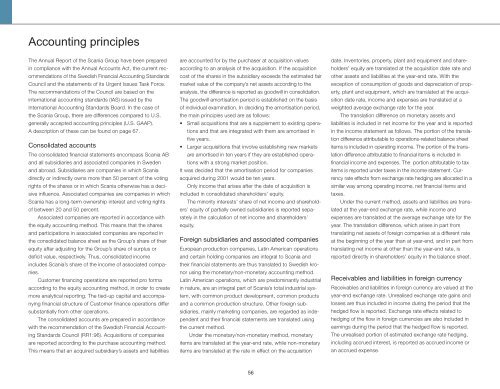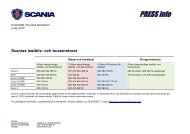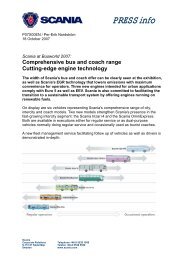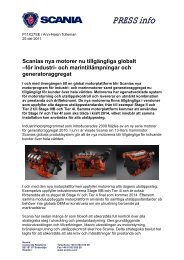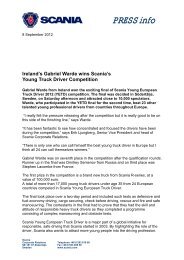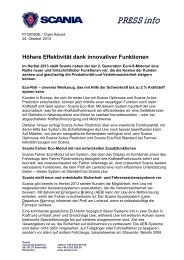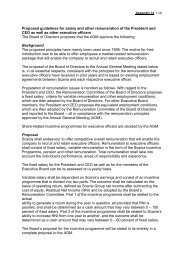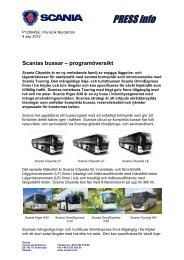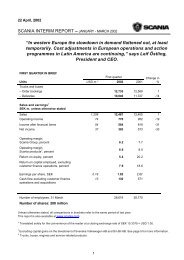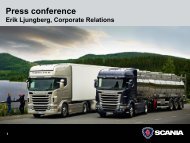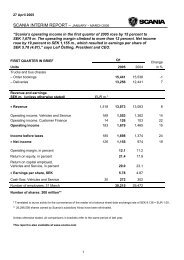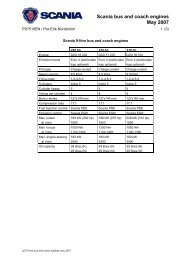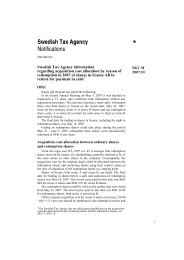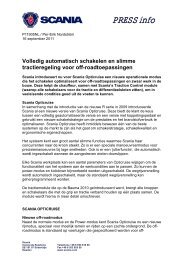Scania annual report 2001
Scania annual report 2001
Scania annual report 2001
You also want an ePaper? Increase the reach of your titles
YUMPU automatically turns print PDFs into web optimized ePapers that Google loves.
Accounting principles<br />
The Annual Report of the <strong>Scania</strong> Group have been prepared<br />
in compliance with the Annual Accounts Act, the current recommendations<br />
of the Swedish Financial Accounting Standards<br />
Council and the statements of its Urgent Issues Task Force.<br />
The recommendations of the Council are based on the<br />
international accounting standards (IAS) issued by the<br />
International Accounting Standards Board. In the case of<br />
the <strong>Scania</strong> Group, there are differences compared to U.S.<br />
generally accepted accounting principles (U.S. GAAP).<br />
A description of these can be found on page 67.<br />
Consolidated accounts<br />
The consolidated financial statements encompass <strong>Scania</strong> AB<br />
and all subsidiaries and associated companies in Sweden<br />
and abroad. Subsidiaries are companies in which <strong>Scania</strong><br />
directly or indirectly owns more than 50 percent of the voting<br />
rights of the shares or in which <strong>Scania</strong> otherwise has a decisive<br />
influence. Associated companies are companies in which<br />
<strong>Scania</strong> has a long-term ownership interest and voting rights<br />
of between 20 and 50 percent.<br />
Associated companies are <strong>report</strong>ed in accordance with<br />
the equity accounting method. This means that the shares<br />
and participations in associated companies are <strong>report</strong>ed in<br />
the consolidated balance sheet as the Group’s share of their<br />
equity after adjusting for the Group’s share of surplus or<br />
deficit value, respectively. Thus, consolidated income<br />
includes <strong>Scania</strong>’s share of the income of associated companies.<br />
Customer financing operations are <strong>report</strong>ed pro forma<br />
according to the equity accounting method, in order to create<br />
more analytical <strong>report</strong>ing. The tied-up capital and accompanying<br />
financial structure of Customer finance operations differ<br />
substantially from other operations.<br />
The consolidated accounts are prepared in accordance<br />
with the recommendation of the Swedish Financial Accounting<br />
Standards Council (RR1:96). Acquisitions of companies<br />
are <strong>report</strong>ed according to the purchase accounting method.<br />
This means that an acquired subsidiary’s assets and liabilities<br />
are accounted for by the purchaser at acquisition values<br />
according to an analysis of the acquisition. If the acquisition<br />
cost of the shares in the subsidiary exceeds the estimated fair<br />
market value of the company’s net assets according to the<br />
analysis, the difference is <strong>report</strong>ed as goodwill in consolidation.<br />
The goodwill amortisation period is established on the basis<br />
of individual examination. In deciding the amortisation period,<br />
the main principles used are as follows:<br />
• Small acquisitions that are a supplement to existing operations<br />
and that are integrated with them are amortised in<br />
five years.<br />
• Larger acquisitions that involve establishing new markets<br />
are amortised in ten years if they are established operations<br />
with a strong market position.<br />
It was decided that the amortisation period for companies<br />
acquired during <strong>2001</strong> would be ten years.<br />
Only income that arises after the date of acquisition is<br />
included in consolidated shareholders’ equity.<br />
The minority interests’ share of net income and shareholders’<br />
equity of partially owned subsidiaries is <strong>report</strong>ed separately<br />
in the calculation of net income and shareholders’<br />
equity.<br />
Foreign subsidiaries and associated companies<br />
European production companies, Latin American operations<br />
and certain holding companies are integral to <strong>Scania</strong> and<br />
their financial statements are thus translated to Swedish kronor<br />
using the monetary/non-monetary accounting method.<br />
Latin American operations, which are predominantly industrial<br />
in nature, are an integral part of <strong>Scania</strong>’s total industrial system,<br />
with common product development, common products<br />
and a common production structure. Other foreign subsidiaries,<br />
mainly marketing companies, are regarded as independent<br />
and their financial statements are translated using<br />
the current method.<br />
Under the monetary/non-monetary method, monetary<br />
items are translated at the year-end rate, while non-monetary<br />
items are translated at the rate in effect on the acquisition<br />
date. Inventories, property, plant and equipment and shareholders’<br />
equity are translated at the acquisition date rate and<br />
other assets and liabilities at the year-end rate. With the<br />
exception of consumption of goods and depreciation of property,<br />
plant and equipment, which are translated at the acquisition<br />
date rate, income and expenses are translated at a<br />
weighted average exchange rate for the year.<br />
The translation difference on monetary assets and<br />
liabilities is included in net income for the year and is <strong>report</strong>ed<br />
in the income statement as follows. The portion of the translation<br />
difference attributable to operations-related balance sheet<br />
items is included in operating income. The portion of the translation<br />
difference attributable to financial items is included in<br />
financial income and expenses. The portion attributable to tax<br />
items is <strong>report</strong>ed under taxes in the income statement. Currency<br />
rate effects from exchange rate hedging are allocated in a<br />
similar way among operating income, net financial items and<br />
taxes.<br />
Under the current method, assets and liabilities are translated<br />
at the year-end exchange rate, while income and<br />
expenses are translated at the average exchange rate for the<br />
year. The translation difference, which arises in part from<br />
translating net assets of foreign companies at a different rate<br />
at the beginning of the year than at year-end, and in part from<br />
translating net income at other than the year-end rate, is<br />
<strong>report</strong>ed directly in shareholders’ equity in the balance sheet.<br />
Receivables and liabilities in foreign currency<br />
Receivables and liabilities in foreign currency are valued at the<br />
year-end exchange rate. Unrealised exchange rate gains and<br />
losses are thus included in income during the period that the<br />
hedged flow is <strong>report</strong>ed. Exchange rate effects related to<br />
hedging of the flow in foreign currencies are also included in<br />
earnings during the period that the hedged flow is <strong>report</strong>ed.<br />
The unrealised portion of estimated exchange rate hedging,<br />
including accrued interest, is <strong>report</strong>ed as accrued income or<br />
an accrued expense.<br />
56


